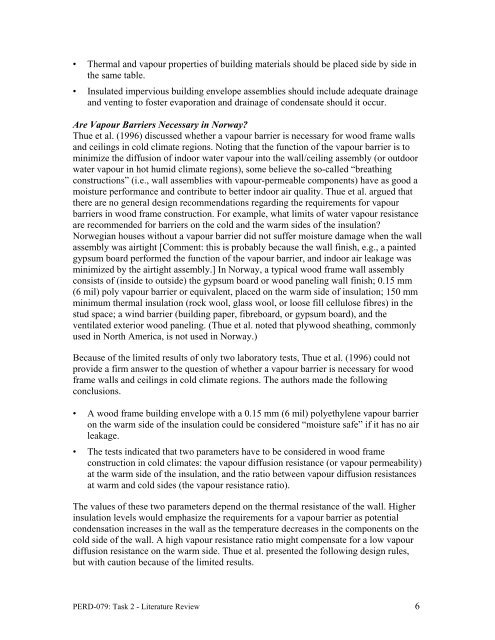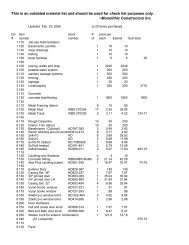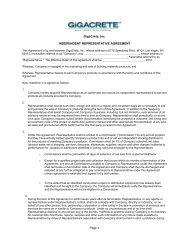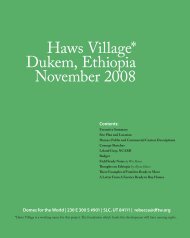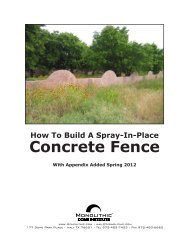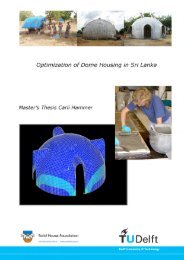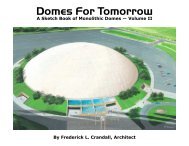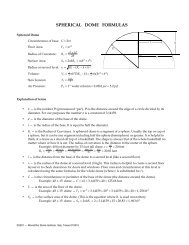Literature Review on Building Envelope, Heating and ... - Beeshive.org
Literature Review on Building Envelope, Heating and ... - Beeshive.org
Literature Review on Building Envelope, Heating and ... - Beeshive.org
Create successful ePaper yourself
Turn your PDF publications into a flip-book with our unique Google optimized e-Paper software.
• Thermal <strong>and</strong> vapour properties of building materials should be placed side by side in<br />
the same table.<br />
• Insulated impervious building envelope assemblies should include adequate drainage<br />
<strong>and</strong> venting to foster evaporati<strong>on</strong> <strong>and</strong> drainage of c<strong>on</strong>densate should it occur.<br />
Are Vapour Barriers Necessary in Norway?<br />
Thue et al. (1996) discussed whether a vapour barrier is necessary for wood frame walls<br />
<strong>and</strong> ceilings in cold climate regi<strong>on</strong>s. Noting that the functi<strong>on</strong> of the vapour barrier is to<br />
minimize the diffusi<strong>on</strong> of indoor water vapour into the wall/ceiling assembly (or outdoor<br />
water vapour in hot humid climate regi<strong>on</strong>s), some believe the so-called “breathing<br />
c<strong>on</strong>structi<strong>on</strong>s” (i.e., wall assemblies with vapour-permeable comp<strong>on</strong>ents) have as good a<br />
moisture performance <strong>and</strong> c<strong>on</strong>tribute to better indoor air quality. Thue et al. argued that<br />
there are no general design recommendati<strong>on</strong>s regarding the requirements for vapour<br />
barriers in wood frame c<strong>on</strong>structi<strong>on</strong>. For example, what limits of water vapour resistance<br />
are recommended for barriers <strong>on</strong> the cold <strong>and</strong> the warm sides of the insulati<strong>on</strong>?<br />
Norwegian houses without a vapour barrier did not suffer moisture damage when the wall<br />
assembly was airtight [Comment: this is probably because the wall finish, e.g., a painted<br />
gypsum board performed the functi<strong>on</strong> of the vapour barrier, <strong>and</strong> indoor air leakage was<br />
minimized by the airtight assembly.] In Norway, a typical wood frame wall assembly<br />
c<strong>on</strong>sists of (inside to outside) the gypsum board or wood paneling wall finish; 0.15 mm<br />
(6 mil) poly vapour barrier or equivalent, placed <strong>on</strong> the warm side of insulati<strong>on</strong>; 150 mm<br />
minimum thermal insulati<strong>on</strong> (rock wool, glass wool, or loose fill cellulose fibres) in the<br />
stud space; a wind barrier (building paper, fibreboard, or gypsum board), <strong>and</strong> the<br />
ventilated exterior wood paneling. (Thue et al. noted that plywood sheathing, comm<strong>on</strong>ly<br />
used in North America, is not used in Norway.)<br />
Because of the limited results of <strong>on</strong>ly two laboratory tests, Thue et al. (1996) could not<br />
provide a firm answer to the questi<strong>on</strong> of whether a vapour barrier is necessary for wood<br />
frame walls <strong>and</strong> ceilings in cold climate regi<strong>on</strong>s. The authors made the following<br />
c<strong>on</strong>clusi<strong>on</strong>s.<br />
• A wood frame building envelope with a 0.15 mm (6 mil) polyethylene vapour barrier<br />
<strong>on</strong> the warm side of the insulati<strong>on</strong> could be c<strong>on</strong>sidered “moisture safe” if it has no air<br />
leakage.<br />
• The tests indicated that two parameters have to be c<strong>on</strong>sidered in wood frame<br />
c<strong>on</strong>structi<strong>on</strong> in cold climates: the vapour diffusi<strong>on</strong> resistance (or vapour permeability)<br />
at the warm side of the insulati<strong>on</strong>, <strong>and</strong> the ratio between vapour diffusi<strong>on</strong> resistances<br />
at warm <strong>and</strong> cold sides (the vapour resistance ratio).<br />
The values of these two parameters depend <strong>on</strong> the thermal resistance of the wall. Higher<br />
insulati<strong>on</strong> levels would emphasize the requirements for a vapour barrier as potential<br />
c<strong>on</strong>densati<strong>on</strong> increases in the wall as the temperature decreases in the comp<strong>on</strong>ents <strong>on</strong> the<br />
cold side of the wall. A high vapour resistance ratio might compensate for a low vapour<br />
diffusi<strong>on</strong> resistance <strong>on</strong> the warm side. Thue et al. presented the following design rules,<br />
but with cauti<strong>on</strong> because of the limited results.<br />
PERD-079: Task 2 - <str<strong>on</strong>g>Literature</str<strong>on</strong>g> <str<strong>on</strong>g>Review</str<strong>on</strong>g> 6


